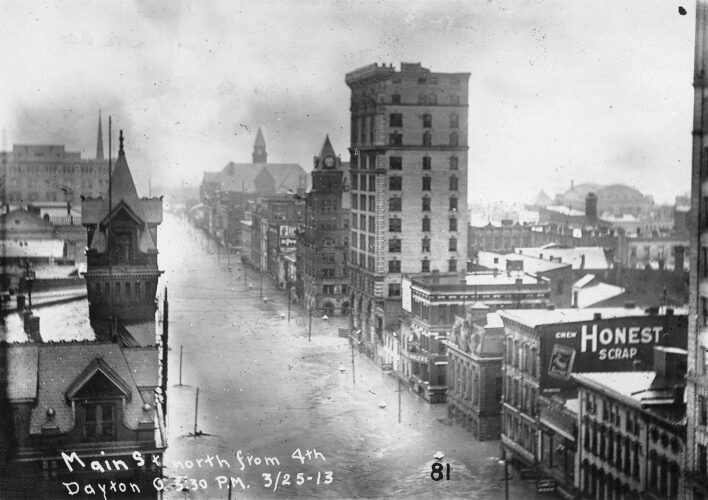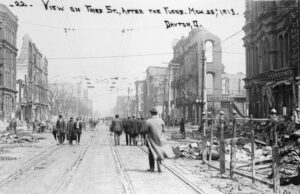The Great Flood of 1913

The Great Flood of 1913 is considered one of the greatest natural disasters in Ohio’s history. In March of 1913, heavy rains exacerbated flood conditions, which were common in many regions of the state. Rivers began to overflow, and eventually preventative levees broke, causing mass flooding. Dayton, Ohio was the city that was hit the hardest, where floodwaters rose in some areas up to 20 feet.

On March 21st, the first storms arrived in the area, bringing with them strong winds. By the 23rd, the soil became almost completely saturated, so all rain became runoff into rivers and tributaries. The Great Miami River reached its maximum fill on the 24th, but it continued to rise and overfill. Soon afterwards, officials throughout Dayton were warned that the levees were beginning to weaken and overflow as well. Within only a few hours, most of the levees had broken and water began to flood into the downtown portion of the city. By the morning of the 26th, portions of the city were under up to 20 feet of water and a gas explosion occurred that resulted in several fires and the destruction of an entire city block.
By the time the flooding began to subside, relief efforts were in full force and being led by John H. Patterson. Patterson was the founder of the National Cash Register Company (NCR), which was based out of Dayton. Before the levee in the city even broke, he organized the NCR Factory to begin manufacturing flat-bottomed boats and converted the space into a shelter for displaced citizens. He organized rescue teams to save the thousands of people who were stranded on roofs and upper stories of buildings. The NCR factory even became a basecamp for news reporters and photographers so that they could continue filing stories and update the public as necessary.

When the flood was over, the damage was overwhelming. At least 428 people had lost their lives, around 65,000 people were displaced, over 20,000 buildings and homes were destroyed, and upwards of $100 million in 1913 dollars’ worth of damage was done. Nevertheless, with all of the damage, the state was determined to prevent this sort of disaster from happening again. The Dayton Citizens Relief Commission was formed following the flood, and it collected more than $2 million to help fund the “flood control effort”. Arthur Morgan, a hydrological engineer, was brought in to design an extensive plan that would protect the city from future catastrophic flooding. Eventually, the Vonderheide Act, or the Ohio Conservancy Law, was passed in 1914. The law gave the state authority to establish watershed districts and continually raise funds through taxes to improve infrastructure that would prevent future flooding. The Miami Conservancy District was created in response to the act and was the first major watershed district in the nation.
Thank you to Katelyn Muraleetharan, Digital Projects Coordinator at the Ohio History Connection, for this week’s post!



Leave a Reply
You must be logged in to post a comment.